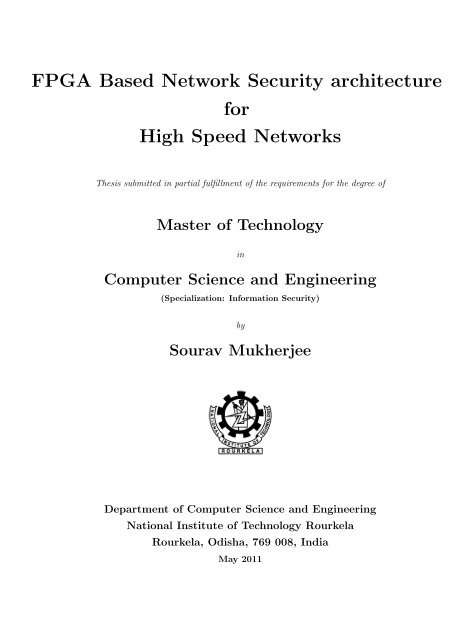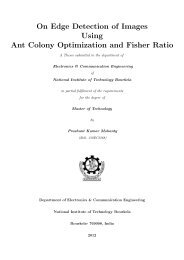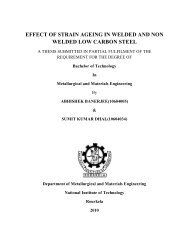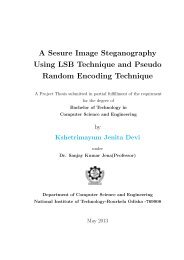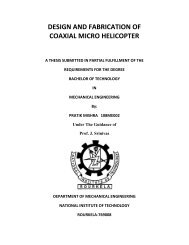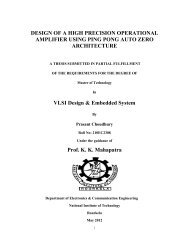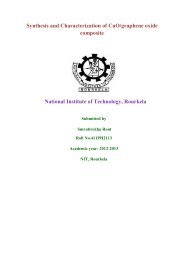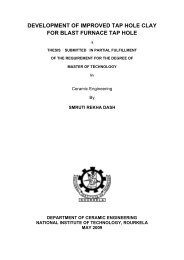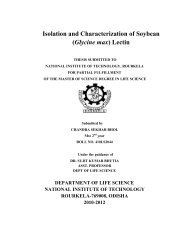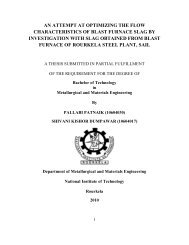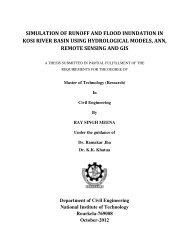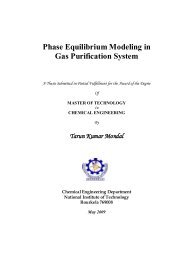FPGA Based Network Security architecture for High Speed Networks
FPGA Based Network Security architecture for High Speed Networks
FPGA Based Network Security architecture for High Speed Networks
You also want an ePaper? Increase the reach of your titles
YUMPU automatically turns print PDFs into web optimized ePapers that Google loves.
<strong>FPGA</strong> <strong>Based</strong> <strong>Network</strong> <strong>Security</strong> <strong>architecture</strong><br />
<strong>for</strong><br />
<strong>High</strong> <strong>Speed</strong> <strong>Network</strong>s<br />
Thesis submitted in partial fulfillment of the requirements <strong>for</strong> the degree of<br />
Master of Technology<br />
in<br />
Computer Science and Engineering<br />
(Specialization: In<strong>for</strong>mation <strong>Security</strong>)<br />
by<br />
Sourav Mukherjee<br />
Department of Computer Science and Engineering<br />
National Institute of Technology Rourkela<br />
Rourkela, Odisha, 769 008, India<br />
May 2011
<strong>FPGA</strong> <strong>Based</strong> <strong>Network</strong> <strong>Security</strong> <strong>architecture</strong><br />
<strong>for</strong><br />
<strong>High</strong> <strong>Speed</strong> <strong>Network</strong>s<br />
Thesis submitted in partial fulfillment of the requirements <strong>for</strong> the degree of<br />
Master of Technology<br />
in<br />
Computer Science and Engineering<br />
(Specialization: In<strong>for</strong>mation <strong>Security</strong>)<br />
by<br />
Sourav Mukherjee<br />
(Roll- 209CS2090)<br />
Supervisor<br />
Prof. Bibhudatta Sahoo<br />
Department of Computer Science and Engineering<br />
National Institute of Technology Rourkela<br />
Rourkela, Odisha, 769 008, India<br />
May 2011
Department of Computer Science and Engineering<br />
National Institute of Technology Rourkela<br />
Rourkela-769 008, Odisha, India.<br />
Certificate<br />
This is to certify that the work in the thesis entitled <strong>FPGA</strong> based <strong>Network</strong><br />
<strong>Security</strong> Architecture <strong>for</strong> <strong>High</strong> <strong>Speed</strong> <strong>Network</strong>s by Sourav Mukherjee<br />
is a record of an original research work carried out by him under my supervision<br />
and guidance in partial fulfillment of the requirements <strong>for</strong> the award of the degree<br />
of Master of Technology with the specialization of In<strong>for</strong>mation <strong>Security</strong> in the de-<br />
partment of Computer Science and Engineering, National Institute of Technology<br />
Rourkela. Neither this thesis nor any part of it has been submitted <strong>for</strong> any degree<br />
or academic award elsewhere.<br />
Place: NIT Rourkela Bibhudatta Sahoo<br />
Date: 30 May 2011 Professor, CSE Department<br />
NIT Rourkela, Odisha
Acknowledgment<br />
It has been a long journey <strong>for</strong> me when I started this work and now when I am<br />
writing this, I am going to take the privilege of thanking those people who assisted<br />
me a lot <strong>for</strong> completing my work .<br />
First of all, I would like to express my sincere thanks to Prof. Bibhudatta Sa-<br />
hoo <strong>for</strong> his advice during my thesis work. As my supervisor, he has constantly<br />
encouraged me to remain focused on achieving my goal. His observations and<br />
comments helped me to establish the overall direction of the research and to move<br />
<strong>for</strong>ward with investigation in depth. He has helped me greatly and been a source<br />
of knowledge.<br />
I am very much indebted to Prof. Ashok Kumar Turuk, Head of the Depart-<br />
ment, CSE, <strong>for</strong> his continuous encouragement and support.I am also thankful to<br />
Dr. B. Majhi, Dr. S. K. Rath, Dr. S. K. Jena, Dr. D. P.Mohapatra, Dr. R.<br />
Baliarsingh, and Dr. P. M. Khilar <strong>for</strong> giving encouragement and sharing their<br />
knowledge during my thesis work.<br />
I am really thankful to my all friends and my lab mates and specially the se-<br />
niors of the VLSI Lab in the ECE department, who helped me every time when I<br />
was in some trouble.<br />
I must acknowledge the academic resources that I have got from NIT Rourkela.<br />
I would like to thank administrative and technical staff members of the Depart-<br />
ment who have been kind enough to advise and help in their respective roles.<br />
Last, but not the least, I would like to dedicate this thesis to my parents and<br />
my sister, <strong>for</strong> their love, patience, and understanding.<br />
Sourav Mukherjee<br />
Email ID: souravaot@gmail.com
Abstract<br />
Cryptography and <strong>Network</strong> <strong>Security</strong> in high speed networks demands <strong>for</strong> spe-<br />
cialized hardware in order to match up with the network speed. These hard-<br />
ware modules are being realized using reconfigurable <strong>FPGA</strong> technology to support<br />
heavy computation. Our work is mainly based on designing an efficient architec-<br />
ture <strong>for</strong> a cryptographic module and a network intrusion detection system <strong>for</strong> a<br />
high speed network. All the designs are coded using VHDL and are synthesized<br />
using Xilinx ISE <strong>for</strong> verifying their functionality. Virtex II pro <strong>FPGA</strong> is chosen<br />
as the target device <strong>for</strong> realization of the proposed design. In the cryptographic<br />
module, International Data Encryption Algorithm (IDEA), a symmetric key block<br />
cipher is chosen as the algorithm <strong>for</strong> implementation. The design goal is to in-<br />
crease the data conversion rate i.e the throughput to a substantial value so that<br />
the design can be used as a cryptographic coprocessor in high speed network ap-<br />
plications. We have proposed a new n bit multiplier in the design which generates<br />
less number of partial products (≤
Contents<br />
Certificate ii<br />
Acknowledgement iii<br />
Abstract iv<br />
List of Figures vii<br />
List of Tables viii<br />
1 Introduction 2<br />
1.1 Motivation . . . . . . . . . . . . . . . . . . . . . . . . . . . . . . . . 3<br />
1.2 Problem Statement . . . . . . . . . . . . . . . . . . . . . . . . . . . 4<br />
1.3 Our Contribution . . . . . . . . . . . . . . . . . . . . . . . . . . . . 5<br />
1.4 Thesis Organization . . . . . . . . . . . . . . . . . . . . . . . . . . . 6<br />
2 Background 8<br />
2.1 Introduction . . . . . . . . . . . . . . . . . . . . . . . . . . . . . . . 8<br />
2.2 Symmetric key Cryptosystem . . . . . . . . . . . . . . . . . . . . . 8<br />
2.2.1 IDEA Encryption Algorithm . . . . . . . . . . . . . . . . . . 8<br />
2.3 Related Work . . . . . . . . . . . . . . . . . . . . . . . . . . . . . . 10<br />
2.4 Conclusion . . . . . . . . . . . . . . . . . . . . . . . . . . . . . . . . 18<br />
3 Modulo (2 16 + 1) multiplier <strong>for</strong> IDEA Cipher 20<br />
3.1 Introduction . . . . . . . . . . . . . . . . . . . . . . . . . . . . . . . 20<br />
3.2 Diminished-one Number Representation . . . . . . . . . . . . . . . 20<br />
3.2.1 Basic Operations . . . . . . . . . . . . . . . . . . . . . . . . 21<br />
3.3 Algorithm <strong>for</strong> the proposed multiplier . . . . . . . . . . . . . . . . . 21<br />
3.4 Proposed multiplier <strong>architecture</strong> . . . . . . . . . . . . . . . . . . . . 26<br />
v
3.5 Complexity of the proposed multiplier : . . . . . . . . . . . . . . . . 27<br />
3.6 Results and Analysis . . . . . . . . . . . . . . . . . . . . . . . . . . 28<br />
3.7 Conclusion . . . . . . . . . . . . . . . . . . . . . . . . . . . . . . . . 29<br />
4 Design and Implementation of IDEA cipher 31<br />
4.1 Introduction . . . . . . . . . . . . . . . . . . . . . . . . . . . . . . . 31<br />
4.2 Design and Architecture using pipelining . . . . . . . . . . . . . . . 31<br />
4.3 Result and comparison with other schemes . . . . . . . . . . . . . . 34<br />
4.3.1 Analysis and Comparison . . . . . . . . . . . . . . . . . . . 34<br />
4.4 Conclusion . . . . . . . . . . . . . . . . . . . . . . . . . . . . . . . . 36<br />
5 <strong>FPGA</strong> based string matching <strong>for</strong> <strong>Network</strong> Intrusion Detection<br />
System 39<br />
5.1 Introduction . . . . . . . . . . . . . . . . . . . . . . . . . . . . . . . 39<br />
5.2 Basic Idea and Related work . . . . . . . . . . . . . . . . . . . . . . 41<br />
5.2.1 NIDS and Multiple pattern matching . . . . . . . . . . . . . 41<br />
5.3 Proposed Design . . . . . . . . . . . . . . . . . . . . . . . . . . . . 43<br />
5.3.1 Bloom Filter basics and overview . . . . . . . . . . . . . . . 44<br />
5.3.2 Scenario 1: With fixed sized matching patterns: . . . . . . . 45<br />
5.3.3 Scenario 2: With variable sized matching patterns: . . . . . 46<br />
5.4 Implementation . . . . . . . . . . . . . . . . . . . . . . . . . . . . . 47<br />
5.4.1 Implementation Constraints . . . . . . . . . . . . . . . . . . 48<br />
5.4.2 Partial and Large Bloom Filter . . . . . . . . . . . . . . . . 48<br />
5.4.3 Hash Function . . . . . . . . . . . . . . . . . . . . . . . . . . 50<br />
5.4.4 Results and Comparison . . . . . . . . . . . . . . . . . . . . 51<br />
5.5 Conclusion . . . . . . . . . . . . . . . . . . . . . . . . . . . . . . . . 53<br />
6 Conclusion and Future Work 56<br />
Bibliography 57<br />
Dissemination of Work 63
List of Figures<br />
2.1 Data flow of IDEA Cipher . . . . . . . . . . . . . . . . . . . . . . . 9<br />
2.2 IDEA Encryption key Generation . . . . . . . . . . . . . . . . . . . 11<br />
3.1 Architecture of six-stage pipelined new modulo (2 16 + 1) multiplier<br />
<strong>for</strong> IDEA . . . . . . . . . . . . . . . . . . . . . . . . . . . . . . . . . 27<br />
3.2 Multiplier giving output in the 7th clock cycle . . . . . . . . . . . . 28<br />
4.1 A single inner round pipelined <strong>architecture</strong> <strong>for</strong> IDEA with 24 pipeline<br />
stages . . . . . . . . . . . . . . . . . . . . . . . . . . . . . . . . . . 32<br />
4.2 Basic Iterative <strong>architecture</strong> with inner round pipelining <strong>for</strong> IDEA . 33<br />
4.3 Partial mixed inner and outer round pipelined <strong>architecture</strong> <strong>for</strong> IDEA 33<br />
4.4 Full mixed inner and outer round pipelined <strong>architecture</strong> <strong>for</strong> IDEA . 35<br />
5.1 Basic Architecture <strong>for</strong> Signature based NIDS . . . . . . . . . . . . . 41<br />
5.2 A Typical Bloom Filter with an Analyzer . . . . . . . . . . . . . . . 45<br />
5.3 Parallel Bloom Filter Matching a fixed sized pattern [1]. . . . . . . 46<br />
5.4 A series of Bloom Filters matching variable sized patterns at a time [1]. 47<br />
5.5 Partial Bloom Filter accepting 2 Hash Functions [2] . . . . . . . . . 49<br />
5.6 Large Bloom Filter using a series of PBFs [2] . . . . . . . . . . . . . 50<br />
5.7 Test-bench <strong>for</strong> the Hash Function Generator . . . . . . . . . . . . . 51<br />
5.8 Timing Summary <strong>for</strong> Hash Generator Module . . . . . . . . . . . . 52<br />
5.9 Wave<strong>for</strong>m <strong>for</strong> the overall design <strong>for</strong> Bloom Filter. Diagram shows<br />
the wave<strong>for</strong>m when the supplied Hash values exactly matches with<br />
the hash values of the member string, the match signal becomes high 52<br />
5.10 Timing Summary <strong>for</strong> the Bloom Filter . . . . . . . . . . . . . . . . 53<br />
vii
List of Tables<br />
3.1 Device utilization and timing analysis <strong>for</strong> the proposed multiplier . 29<br />
4.1 Comparison of the three different <strong>architecture</strong>s implemented in <strong>FPGA</strong>.<br />
S is the number of total number of pipelined stages in the archi-<br />
tecture, F is the clock frequency achieved by the design, T is the<br />
throughput of the design, N is the number of slices consumed by<br />
the design, R is the Throughput to Area ratio.’. . . . . . . . . . . . 36<br />
4.2 Comparison of our proposed design with some existing designs . . . 36<br />
5.1 Comparison of our proposed design with some existing designs . . . 53<br />
viii
Introduction<br />
Motivation<br />
Problem Statement<br />
Our Contribution<br />
Thesis Organization
Chapter 1<br />
Introduction<br />
In the field of networking, role of network security is immense. It is a very vital<br />
tool which provides the security against various external and internal threats in<br />
any network. To understand the theory of network security, the understanding<br />
and knowledge of different threats in the network. To maintain network security<br />
in a network involves the fulfilment of the security goals in the network which are<br />
Data Confidentiality, Integrity , Authentication and Non-Repudiation.<br />
Data confidentiality is achieved by means of Cryptography. The aim of cryptog-<br />
raphy is to secure in<strong>for</strong>mation so that only the intended parties can read the data.<br />
Cryptosystems had been developed <strong>for</strong> centuries. As computer technologies are<br />
getting advanced, more and more cryptographic applications are used. They are<br />
mainly used to support other applications which are very much sensitive to data<br />
security such as smart cards and commercial data exchange over a network. Not<br />
only <strong>for</strong> personal use but cryptographic algorithms are also very important in ev-<br />
ery aspect of professional activities. A cryptographic algorithm generally consists<br />
of some specialized arithmetic computations which are complicated in terms of<br />
time complexity. It is because of the fact that these algorithms work with large<br />
amount of data either in blocks or simply in streams. Although a single traditional<br />
CPU is enough <strong>for</strong> per<strong>for</strong>ming these computations, but <strong>for</strong> a machine which works<br />
as a server in a huge network gets millions of client requests <strong>for</strong> per<strong>for</strong>ming cryp-<br />
tographic operations <strong>for</strong> them individually. This makes the workload huge. The<br />
computational resources may also be limited <strong>for</strong> example in smartcards, mobile<br />
phones, handheld computers, etc. Moreover if the associated network is of high<br />
2
1.1 Motivation<br />
speed, the speed of the necessary cryptographic computations also needs to be<br />
taken into account. For example in transmitting audio and video data <strong>for</strong> cable<br />
TV, video conferencing and sensitive financial and commercial data, the speed of<br />
the cryptographic module to be embedded ,needs to be very high. Moreover <strong>for</strong><br />
security related issues in wireless and sensor networks, there is a need <strong>for</strong> separate<br />
hardware device with very high processing rate because of limited battery of the<br />
nodes and <strong>for</strong> optimizing the bandwidth efficiency. So from the viewpoint of high<br />
speed and throughput, traditional software implementations of these complicated<br />
cryptographic algorithms are not efficient in real time applications like ATM, VPN,<br />
etc. This <strong>for</strong>ces the system designers to go <strong>for</strong> hardware implementation of the<br />
cryptosystems.<br />
1.1 Motivation<br />
The demand <strong>for</strong> new network security systems is increasing with the growth of<br />
network services in our society. Several heuristics are associated <strong>for</strong> judging the<br />
network per<strong>for</strong>mances. In today’s world, speed is considered as one of such heuris-<br />
tics. Moreover various network applications are being installed <strong>for</strong> reducing the<br />
network overhead, specially the data traffic in remote servers. Such types of appli-<br />
cations are basically used <strong>for</strong> satisfying the security goals, namely confidentiality,<br />
integrity, authentication and non repudiation. Majority of these applications are<br />
very much computationally intensive and software approach <strong>for</strong> these applications<br />
is rather inefficient to work in line speed of the network. So the current trend is<br />
to replace such software applications with specialized hardware which are quite<br />
compatible to work in such high speed. There are certain key points which can be<br />
chosen as motivation <strong>for</strong> this work. These are as follows.<br />
• For maintaining security over Internet and E-Commerce, cryptography and<br />
security is of vital importance.<br />
• For per<strong>for</strong>ming cryptographic and other network security management op-<br />
erations, some heavy computations are necessary and per<strong>for</strong>ming them at a<br />
line speed of the network is a challenging task. Software based applications<br />
3
1.2 Problem Statement<br />
cannot guarantee such speed, so there is an increasing demand <strong>for</strong> hardware<br />
based appliances.<br />
• <strong>FPGA</strong> technology allow reconfigurability in any design and at the same time<br />
any <strong>architecture</strong> can exploit parallelism and concurrency when implemented<br />
in <strong>FPGA</strong>. So a lot of research work is now based on <strong>FPGA</strong> implementations<br />
of cryptographic algorithms.<br />
• Finally one algorithm can be implemented in a variety of <strong>architecture</strong>s, each<br />
having some speciality. By varying the <strong>architecture</strong>s, different design objec-<br />
tives can be achieved which increases the flexibility of the algorithm.<br />
1.2 Problem Statement<br />
The main objectives of our work is to design, synthesize and verify the function-<br />
ality of certain modules that are highly computationally intensive and are highly<br />
challenging to make them work as an independent module in a high speed network.<br />
This can be said in detail as :<br />
1. In the context of confidentiality, the motive is to design an efficient architec-<br />
ture <strong>for</strong> a symmetric key block cipher and implement using <strong>FPGA</strong> technol-<br />
ogy. The target is to reduce the modular complexity of the round operations<br />
of the cipher so that the per<strong>for</strong>mance parameters can be optimized. This<br />
is to support the argument that building a cryptosystem completely on an<br />
<strong>FPGA</strong> plat<strong>for</strong>m is possible.<br />
2. Exploit the concurrent characteristics of <strong>FPGA</strong> to include Outer Round and<br />
Inner Round Pipelining in our design. Finally the goal is to visualize their<br />
impact on system per<strong>for</strong>mance.<br />
3. Design a novel <strong>architecture</strong> <strong>for</strong> a multiple pattern string matching algorithm<br />
which can be used as a pattern matching module in a <strong>Network</strong> <strong>Based</strong> Intru-<br />
sion Detection System(NIDS).<br />
4
1.3 Our Contribution<br />
1.3 Our Contribution<br />
In this work, a set of computationally intensive modules are designed and and<br />
their per<strong>for</strong>mances are evaluated so as to verify their functionality as a separate<br />
application in a high speed network. For each and every design, the ultimate goal<br />
is to optimize the per<strong>for</strong>mance parameters i.e. to maximize the system through-<br />
put by maximizing the operating frequency of the design and to minimize the area<br />
requirements so that it validates the
1.4 Thesis Organization<br />
from the module.However, there may be possibility of false positives in the<br />
system.<br />
1.4 Thesis Organization<br />
In this chapter, the motivation <strong>for</strong> hardware implementation of networks security<br />
applications, the objectives of our work and our contribution is discussed in a nut-<br />
shell. The organization of the rest of the thesis and a brief outline of the chapters<br />
in this thesis are as given below.<br />
In chapter 2, we have discussed the basic algorithm and theory of IDEA, the<br />
symmetric key block cipher, which is chosen <strong>for</strong> implementation in <strong>FPGA</strong>. More-<br />
over we have discussed the previous implementation details of IDEA in hardware.<br />
In chapter 3, we have described our proposed modulo multiplier <strong>architecture</strong><br />
using Diminished-one number representation and Booth’s algorithm and analyzed<br />
how it reduces the modular complexity in IDEA round operations.<br />
In chapter 4, we have described the per<strong>for</strong>mance of IDEA on <strong>FPGA</strong> using<br />
our proposed multiplier and a combination of outer and inner round pipelining.<br />
We analyzed our <strong>architecture</strong> in terms of Alice counts and throughput.<br />
In chapter 5, we have proposed and implemented a novel string matching al-<br />
gorithm <strong>for</strong> a <strong>Network</strong> <strong>Based</strong> Intrusion Detection System using a memory efficient<br />
multi hashing data structure called Bloom Filter.<br />
Finally, in chapter 6, we draw our conclusion and proposed some additional<br />
ideas <strong>for</strong> our future work.<br />
6
Background<br />
Introduction<br />
Symmetric key Cryptosystem<br />
Previous implementations of IDEA in Hardware<br />
Conclusion
Chapter 2<br />
Background<br />
2.1 Introduction<br />
In this chapter, we have discussed the basic theory and algorithm <strong>for</strong> International<br />
data Encryption algorithm (IDEA), a symmetric block cipher, which is selected<br />
as a cipher <strong>for</strong> implementation in <strong>FPGA</strong> technology. This chapter consists of two<br />
parts. In the first part, the IDEA algorithm and basics have been discussed. In<br />
the second part, a detailed literature study of the previous implementations of<br />
IDEA in hardware is covered.<br />
2.2 Symmetric key Cryptosystem<br />
In symmetric key cryptography, the encryption and decryption process is done<br />
by the same key which is the secret key. This secret key is shared prior to the<br />
encryption process and remains constant during the process. In our work, we have<br />
used International Data Encryption Algorithm as the symmetric key block cipher<br />
module and we focussed mainly on reducing the round complexity and increasing<br />
the throughput <strong>for</strong> the overall design.<br />
2.2.1 IDEA Encryption Algorithm<br />
The proposed Encryption Standard (PES) is a block cipher introduced by Lai and<br />
Massey [4, 5]. It was then improved by the Lai, Massey and Murphy in 1991.<br />
This version, with stronger security against differential analysis and truncated<br />
differentials, was called the Improved PES (IPES). IPES was renamed to be the<br />
8
2.2 Symmetric key Cryptosystem<br />
International Data Encryption Algorithm (IDEA) [6] in 1992. Claims have been<br />
made that the algorithm is the most secure block encryption algorithm in the<br />
public domain.<br />
Basic Structure<br />
Figure 2.1: Data flow of IDEA Cipher<br />
IDEA is a symmetric, secret-key block cipher. The keys <strong>for</strong> both encryption<br />
and decryption must be kept secret from unauthorized persons. Since the two<br />
keys are symmetric, one can divide the decryption key from the encryption one or<br />
vice versa. The size of the key is fixed to be 128 bits and the size of the data block<br />
which can be handled in one encryption/decryption process is fixed to 64 bits. All<br />
data operations in the IDEA cipher are in 16-bit unsigned integers. When pro-<br />
cessing data which is not an integer multiple of 64-bit block, padding is required.<br />
The security of IDEA algorithm is based on the mixing of three different kinds<br />
of algebraic operations: EX-OR, addition and modular multiplication. IDEA is<br />
based upon a basic function, which is iterated eight times. The first iteration<br />
operates on the input 64-bit plain text block and the successive iterations operate<br />
on the 64-bit block from the previous iteration. After the last iteration, a final<br />
9
2.3 Related Work<br />
trans<strong>for</strong>m step produces the 64-bit cipher block.The data flow graph is shown in<br />
Figure 2.1. The algorithm structure has been chosen such that, with the exception<br />
that different key sub-blocks are used, the encryption process is identical to the<br />
decryption process. IDEA uses both confusion and diffusion to encrypt the data.<br />
Three algebraic groups, EX-OR, addition modulo 2 16 , and multiplication modulo<br />
(2 16 + 1), are mixed, and they are all easily implemented in both hardware and<br />
software. All these operations operate on 16-bit sub-blocks.<br />
Key Generation<br />
The key generation phase of IDEA generates 52 sub-keys from the 128 bit input<br />
key. The block diagram <strong>for</strong> key generation is shown in Figure 2.2. The basic steps<br />
of generating the encryption keys are:<br />
• All the sub-keys are named as
Figure 2.2: IDEA Encryption key Generation<br />
2.3 Related Work<br />
as to provide the quality of service.In this scenario, a software implementations<br />
of such algorithm using general purpose processors due to delay in instruction<br />
processing.But such speed can be easily achieved when implemented in hard-<br />
ware.Although the software implementation is less costly than hardware imple-<br />
mentation, the speed up in hardware is very high.So <strong>for</strong> flexibility,availability and<br />
high functionality, there is a need of incorporating a separate cryptographic mod-<br />
ule in such applications.<br />
Although IDEA involves only simple 16-bit operations, software implemen-<br />
tations of this algorithm still cannot offer the encryption rate required <strong>for</strong> on-<br />
line encryption in high-speed networks.IDEA has been previously implemented in<br />
hardware using various <strong>FPGA</strong> devices and even ASIC. Like other renowned sym-<br />
metric key block ciphers, IDEA contains no S-Boxes or P- Boxes. So there is a less<br />
memory overhead.Instead it has some basic building blocks like EX-OR, addition<br />
modulo 2
2.3 Related Work<br />
put rate and the area and cost efficiency depends a lot on efficient design of the<br />
multiplier.<br />
IDEA was first implemented and verified in VLSI by Bonnenberg [7] where the<br />
data encryption and decryption was per<strong>for</strong>med on a single hardware unit which<br />
was a 1.5
2.3 Related Work<br />
implementation is that, the data encryption and decryption was implemented on a<br />
single hardware unit.With a system clock frequency of 25 MHz the data through-<br />
put rate was found to be 177 Mb/s.This was the first silicon block which was<br />
found compatible <strong>for</strong> online encryption in high speed networks.The design was<br />
made using eight pipelining stages, containing a single round to achieve temporal<br />
parallelism.<br />
As usual, the design of modulo (2
2.3 Related Work<br />
was needed to manage through buffers.The overall <strong>architecture</strong> of Curiger’s de-<br />
sign [10] contains two on chip buffer memory <strong>for</strong> implementing the different modes<br />
of operation of the cipher.In each buffer, a 8 × 64 bit shift register is used <strong>for</strong> im-<br />
plementing eight stage pipeline.<br />
In VLSI circuits, arrival of temporary or permanent faults are very common<br />
which creates error in encryption. To get rid of these faults, necessary fault detec-<br />
tion tests are required. These tests can be off-line or online. But if these tests are<br />
periodic, it consumes unnecessary clock cycles and degrades the speed. For test-<br />
ing the overall functionality during encryption,an online built in self test scheme<br />
was added which was done by incorporating a fifth multiplier in the pipeline cir-<br />
cuitry.The drawback in this approach was that, this hardware redundancy resulted<br />
in a large extra hardware. Moreover if the time between two tests was long, there<br />
was a probability of some short-lived error to creep in. Although, the proposed<br />
design was not the fastest single chip implementation but it was the first design<br />
which was found compatible <strong>for</strong> use in high speed networks.<br />
Although the design proposed in [10] was compatible <strong>for</strong> real time encryption<br />
in high speed networks, there was still a demand <strong>for</strong> hardware with faster en-<br />
cryption ability. Moreover Curiger’s design [10] was not capable of detecting all<br />
possible errors during its normal operation.Wolter’s design [12] of a new hardware<br />
<strong>for</strong> IDEA was motivated by the requirement of higher data rate and online testing<br />
of circuit.The design was done by implementing one round of IDEA in a 0.8
2.3 Related Work<br />
i.e mod 3 residue code and the second test was based on redundant test words.<br />
Although this scheme has a data throughput rate of 355 Mb/s by implementing<br />
a single round, due to overhead of online tests on chip, some additional area re-<br />
quirements was required in this design.<br />
The next implementation of IDEA was made by Salomao [13] on an Applica-<br />
tion Specific IC named HiPCrypto using a 0.7
• <strong>High</strong> degree of fine grain parallelism.<br />
2.3 Related Work<br />
• Scalable and thus the trade-offs between data conversion rate and the area<br />
can be addressed.<br />
• <strong>High</strong> clock rate.<br />
• Compact implementation.<br />
The design <strong>for</strong> the modulo (2 16 + 1) was done using the approach proposed by<br />
Meier and Zimmerman and described by Curiger [9] in which, modulo 2
2.3 Related Work<br />
ule, bit parallel multiplier was used and <strong>for</strong> modulo (2 16 + 1) correction, low-high<br />
algorithm [4] was used. For the overall design, a scalable pipeline was used where<br />
the number of pipeline stages were decided during compilation time. The de-<br />
sign achieved a throughput rate of 1500 Mb/s.The drawback of the scheme is<br />
that, the area requirements is not fixed every time due to variation of pipelined<br />
stages.Moreover, due to session initialization and key calculation, the overall per-<br />
<strong>for</strong>mance is slightly low in this scheme.<br />
Cheung and Leong [19] further implemented IDEA on a bit parallel architec-<br />
ture [16] on Xilinx Virtex XCV300-6 <strong>FPGA</strong> and achieved a data throughput of<br />
1166 Mb/s at a system clock rate of 82 MHz.The implementation was runtime<br />
reconfigurable and by direct modification of bitstream downloaded to the <strong>FPGA</strong>,<br />
the key scheduling was done.Moreover, the implementation was scalable with in-<br />
creased resource requirements.With a full hardware support, a throughput of 5.25<br />
Gb/s was estimated using this design.<br />
With a fully pipelined approach, IDEA was implemented by Hamalainen [20]<br />
using Xilinx XCV1000E-6BG560 <strong>FPGA</strong> and the throughput of 8 Gb/s through-<br />
put was achieved by the design.The modulo multiplier used diminished-1 number<br />
representation [11] and the multiplication schemes used in [21] [22], [8], [23] were<br />
implemented and compared.Finally, the multiplication scheme of [22] was chosen.<br />
For cyclic left shifts, extra combinational logic was used and Carry save adders<br />
were used <strong>for</strong> multi-operand addition.The entire design was made using loop un-<br />
rolling <strong>architecture</strong> but it was slightly less efficient in terms of area requirements.<br />
Till now, the fastest <strong>FPGA</strong> implementation was done by Gonzalez [24] where<br />
a throughput of 8.3 Gb/s was achieved using Xilinx Virtex XCV600-6 device. The<br />
speciality of this design was that, all the operational units were replaced by con-<br />
stants and a partial reconfiguration was used along with superpipelining.The only<br />
drawback <strong>for</strong> this scheme is that, not many devices support partial reconfigura-<br />
tion.<br />
Using embedded multipliers, IDEA was implemented by Pan and a throughput<br />
of 6 Gb/s was achieved but the design was costly in terms of area efficiency.An<br />
17
2.4 Conclusion<br />
efficient VLSI implementation of IDEA was done by Thaduri [25] using Altera<br />
<strong>FPGA</strong>, where the modulo multiplier was optimized by using Wallace trees and<br />
carry look ahead adders and a deep temporal parallelism was exploited.The spe-<br />
ciality of the design is that, the sub-keys are generated internally once the original<br />
key is fetched.Moreover, the design did not use any additional RAM <strong>for</strong> storing<br />
the subkeys.Using a clock frequency of 10 MHz, a throughput greater than 700<br />
Mb/s was achieved by the design. In terms of scalability, a throughput of 7.8 Gb/s<br />
was achieved using scaling.<br />
2.4 Conclusion<br />
In this chapter, the <strong>architecture</strong> and algorithm <strong>for</strong> IDEA cipher is discussed in<br />
details. Moreover a background study on the previous hardware implementations<br />
of IDEA has been discussed in details and an analysis is drawn in terms of modular<br />
complexity. In the next chapter, we will discuss our proposed multiplier and its<br />
<strong>architecture</strong> as well as complexity.<br />
18
Modulo multiplier <strong>for</strong> IDEA Cipher<br />
Introduction<br />
Diminished-one Number Representation<br />
Algorithm <strong>for</strong> the proposed multiplier<br />
Proposed multiplier <strong>architecture</strong><br />
Complexity of the proposed multiplier<br />
Conclusion
Chapter 3<br />
Modulo (2 16 + 1) multiplier <strong>for</strong><br />
IDEA Cipher<br />
3.1 Introduction<br />
The basic design goals <strong>for</strong> hardware implementation of any algorithm is to reduce<br />
the time complexity <strong>for</strong> fast execution, optimization of basic modules and reduc-<br />
ing the response time of the algorithm. IDEA is based on three algebraic group<br />
operations on 16 bit unsigned integers which are EX-OR, addition modulo 2 16 and<br />
multiplication modulo (2 16 + 1) [26]. Among these, the multiplication module is<br />
the most complex module because of 16 bit multiplication and modulo correction.<br />
Thus efficient design of these multipliers is a major issue <strong>for</strong> optimizing the per-<br />
<strong>for</strong>mance of IDEA. In our design, we have proposed a new <strong>architecture</strong> <strong>for</strong> the<br />
multiplication module which is based on diminished-one number representation<br />
and radix 8 Booth’s recoding algorithm. This multiplier generates less number of<br />
partial products as compared to previous implemented multipliers and there is no<br />
extra overhead <strong>for</strong> modulo correction.<br />
3.2 Diminished-one Number Representation<br />
The diminished-one number representation proposed by Leibowitz [27], is a very<br />
convenient and efficient <strong>for</strong>m of representation of binary numbers in arithmetic<br />
modulo (2
3.3 Algorithm <strong>for</strong> the proposed multiplier<br />
needs to be (16+1) bit. So unnecessarily an extra bit is used. To avoid this incon-<br />
venience, normal binary operands are trans<strong>for</strong>med to diminished-one operands by<br />
subtracting one from normal binary representation of any number. So if A is an<br />
n+1 bit binary number, then the diminished-one representation of A which is an<br />
n bit number and denoted by d[A], is given by
3.3 Algorithm <strong>for</strong> the proposed multiplier<br />
complexities was more. Chen and Yao [28] proposed modulo (2
or,<br />
<br />
<br />
+
3.3 Algorithm <strong>for</strong> the proposed multiplier<br />
Here ¯
3.3 Algorithm <strong>for</strong> the proposed multiplier<br />
• When n is not divisible by 3, there are two possible solutions<br />
or,
3.4 Proposed multiplier <strong>architecture</strong><br />
operand is the diminished-one <strong>for</strong>m of 2 16 . For example, if A is a 16 bit operand<br />
in IDEA cipher, then A = 0 implies that A = 2 16 . So
3.5 Complexity of the proposed multiplier :<br />
Figure 3.1: Architecture of six-stage pipelined new modulo (2 16 + 1) multiplier <strong>for</strong><br />
IDEA<br />
3.5 Complexity of the proposed multiplier :<br />
The qualitative comparison of the proposed multiplier is made using unit gate<br />
model as proposed by Tyagi [29]. According to this model, an Ex-OR/ Ex-NOR<br />
gate is charged 2 gate delay units and a delay through an elementary gate is taken<br />
as 1 gate delay units. The latency <strong>for</strong> the proposed multiplier consists of the<br />
delay of the PPDG module, the delay of the CSA tree and the delay of the final<br />
diminished-one adder. The PPDG module consists of BE, BS and one diminished-<br />
one adder. The delay in diminished-one adder as given in [28] is 2⌈log 2
or
3.7 Conclusion<br />
outputs are generated in the subsequent clock cycles i.e. eighth,ninth, etc. The<br />
wave<strong>for</strong>m generated in the synthesis report <strong>for</strong> the multiplier module is shown in<br />
Figure 3.2. The device utilization summary and the timing analysis is given in<br />
Table 3.1.<br />
Table 3.1: Device utilization and timing analysis <strong>for</strong> the proposed multiplier<br />
3.7 Conclusion<br />
Parameters Values<br />
Maximum Frequency 723.668 MHz<br />
Device Virtex 2 pro - XC2VP30<br />
Number of Slices 496<br />
Slices available 13696<br />
Percentage of utilization 3<br />
In this chapter, we have proposed and discussed a novel <strong>architecture</strong> <strong>for</strong> a modulo<br />
multiplier <strong>for</strong> the IDEA cipher. The multiplication approach is quite efficient in<br />
terms of number of partial products (which is less than
Design and Implementation of IDEA<br />
Introduction<br />
Design and Architecture using pipelining<br />
Result and comparison with other schemes<br />
Conclusion
Chapter 4<br />
Design and Implementation of<br />
IDEA cipher<br />
4.1 Introduction<br />
There are various goals <strong>for</strong> implementing any design in hardware as mentioned<br />
in [30]. For some designs, optimizing area requirements is a primary goals. For<br />
other designs where speed is an essential criteria, the objective is to increase the<br />
throughput and reduce the latency. The main parameters which are taken into<br />
account <strong>for</strong> implementing a block cipher in hardware are Encryption(Decryption)<br />
throughput and the circuit area. When large amounts of data are associated in<br />
any application, throughput is the best measure <strong>for</strong> the cipher speed. For ap-<br />
plications with small data usage, latency is taken as an additional per<strong>for</strong>mance<br />
parameter, along with throughput. Circuit area usually determines the cost of<br />
implementation which helps to estimate the required
4.2 Design and Architecture using pipelining<br />
Various new design methodologies of secret key clock ciphers have been dis-<br />
cussed in [31].Our implementation follows three of these new design methodologies.<br />
All these designs are first synthesized in VHDL <strong>for</strong> functionality verification. Then<br />
they are implemented in Xilinx Virtex II Pro - XCVP30 <strong>FPGA</strong>. Primarily a single<br />
round is designed with optimum number of pipelined registers inserted inside the<br />
round. A similar type of design with inner round pipelining is followed in [32]. In<br />
Figure 4.1: A single inner round pipelined <strong>architecture</strong> <strong>for</strong> IDEA with 24 pipeline<br />
stages<br />
this design, a 24 stage pipelining is used which guarantees optimum throughput.<br />
However, as mentioned be<strong>for</strong>e, each multiplication module inside the round has 6<br />
pipelined stages whereas <strong>for</strong> addition and XOR module, a single stage is used. The<br />
pipelined data flow in one round is shown in Figure.4.1. For this single round, the<br />
minimum clock period is found to be 9.749 ns in Virtex II Pro i.e the maximum<br />
clock frequency is 102.63 MHz. This design uses a slice count of 2340.<br />
The first design implemented is the iterative design of this inner round pipelined<br />
single round. This is same like implementing a single round of IDEA and repeat-<br />
ing it a number of times. The iteration is made <strong>for</strong> 8 rounds and a final output<br />
trans<strong>for</strong>mation round is implemented at last. The <strong>architecture</strong> of this design is<br />
given in Figure.4.2. The design is found to have a maximum clock frequency of<br />
102.637 MHz with slice counts of 2340 in Virtex II pro . No outer round pipelined<br />
32
4.2 Design and Architecture using pipelining<br />
Figure 4.2: Basic Iterative <strong>architecture</strong> with inner round pipelining <strong>for</strong> IDEA<br />
stages is used in this design. In each iteration, data flow through a single round<br />
with 24 stages of pipeline. The constraint of this design is that, new data <strong>for</strong><br />
encryption can be fed into the system only after the completion of all the rounds.<br />
Figure 4.3: Partial mixed inner and outer round pipelined <strong>architecture</strong> <strong>for</strong> IDEA<br />
In the second modified design, the design is based on partial mixed inner<br />
and outer round pipelining. This design has a much higher throughput with a<br />
marginal increase in circuit area. So in this case the throughput to area ratio<br />
33
4.3 Result and comparison with other schemes<br />
increases. In this design, 4 complete rounds are unrolled , each with 24 stages<br />
on inner pipelined stages. This 4 unrolled round design is iterated twice and the<br />
output trans<strong>for</strong>mation stage is added in the end. With this design, the maximum<br />
clock frequency is found to be 105.91 MHz with a consumption of 9471 slices in<br />
Virtex II pro. The <strong>architecture</strong> of this design is given in Figure.4.3 The number<br />
of pipelined stages used in this design is [(24 × 4) + 3] = 99.<br />
The third design is based on full mixed inner and outer round pipelining. This<br />
design is made so as to achieve the optimum throughput by increasing the clock<br />
frequency. Virtex II Pro doesn’t have the required slices <strong>for</strong> all the IDEA rounds in<br />
unrolled basis. So only 6 rounds are unrolled along with the output trans<strong>for</strong>mation<br />
round. The design gives the throughput with a clock frequency of 117.61 MHz in<br />
Virtex II Pro. A total of [(24×6)+5) = 149 pipelined stages is used in this design.<br />
For placing all the rounds, a total of [(24 × 8) + 8) = 199 pipelined stages As a<br />
result, it has more area requirement in terms of registers usage. The speciality<br />
of this design over the previous design is that, new data can be taken as input<br />
<strong>for</strong> encryption in every clock cycle, after that initial latency of the design. The<br />
<strong>architecture</strong> of the design is shown in Figure.4.4<br />
4.3 Result and comparison with other schemes<br />
In this section, needful results are analyzed and compared based on certain criteria.<br />
At first, the complexity of the proposed multiplier is defined. Next a detailed<br />
comparison is drawn <strong>for</strong> three different <strong>architecture</strong>s implemented based on the<br />
per<strong>for</strong>mance parameters like throughput, slice counts and throughput to area ratio.<br />
Finally, the overall result is compared with some of the previous implemented<br />
schemes.<br />
4.3.1 Analysis and Comparison<br />
The comparison of the three <strong>architecture</strong>s implemented are given in Table 4.1 <strong>for</strong><br />
Virtex II pro <strong>FPGA</strong> device, which is made based on the per<strong>for</strong>mance parameters<br />
like slice counts, throughput and throughput to area ratio. The target device is<br />
34
4.3 Result and comparison with other schemes<br />
Figure 4.4: Full mixed inner and outer round pipelined <strong>architecture</strong> <strong>for</strong> IDEA<br />
chosen as Virtex II pro . The design is synthesized using VHDL and the func-<br />
tionality verification is made using Chipscope pro. The comparison shows that<br />
as the number of pipelined stages increases, the throughput increases but the<br />
slice counts also increases to a certain amount. Due to this, the throughput to<br />
area ratio decreases slightly. However, this trade-off can be accepted as long as<br />
throughput is getting optimized. It is to be noted that in this design, no embed-<br />
ded multipliers are used and so there is no restriction in number of multipliers to<br />
be used. While implementing IDEA on Virtex II pro, using full mixed outer and<br />
inner round pipelining approach , it is found that all the rounds of IDEA cannot<br />
be accommodated in the device. So only 6 rounds are unrolled and implemented<br />
<strong>for</strong> verification.<br />
A brief comparison of per<strong>for</strong>mance is made in Table 4.2 between our design<br />
and some existing designs of [33], [32] and [24]. The comparison is made based on<br />
the parameters like Throughput, Slice counts, Latency etc.<br />
35
4.4 Conclusion<br />
Table 4.1: Comparison of the three different <strong>architecture</strong>s implemented in <strong>FPGA</strong>.<br />
S is the number of total number of pipelined stages in the <strong>architecture</strong>, F is the<br />
clock frequency achieved by the design, T is the throughput of the design, N is<br />
the number of slices consumed by the design, R is the Throughput to Area ratio.’.<br />
Iterative Partial Mixed Full Mixed<br />
Virtex II pro<br />
S 24<br />
F 102.637<br />
T 821<br />
N 2339<br />
R 0.351<br />
Virtex II pro<br />
S 99<br />
F 125.91<br />
T 3021.8<br />
N 8117<br />
R 0.372<br />
Virtex II pro<br />
S 199<br />
F 153.8<br />
T 9843.2<br />
N 11202<br />
R 0.878<br />
Table 4.2: Comparison of our proposed design with some existing designs<br />
Design Device Throughput Slices Latency<br />
Our design (V2)XC2VP30 9.61 Gbps 11202 199-795 cycles<br />
Granado’s design (V2)XC2V6000 27.948 Gbps 15016 182-833 cycles<br />
Gonzalez’s design (V2)XCV600 8.3 Gbps 6078 158-1205 cycles<br />
Hamalainen’s design (V2)XCV2000E 6.8 Gbps 8640 132-1250 cycles<br />
4.4 Conclusion<br />
In this chapter, we have proposed a new design <strong>for</strong> implementing IDEA cipher in<br />
hardware. We have incorporated a new design <strong>for</strong> modulo multiplication module<br />
which generates less than
4.4 Conclusion<br />
consumption of power has not been considered in this design at present. In future,<br />
the design may be extended to that with low power and high throughput.<br />
37
<strong>FPGA</strong> based string matching <strong>for</strong> NIDS<br />
Introduction<br />
Basic Idea and Related work<br />
Proposed Design<br />
Implementation<br />
Conclusion
Chapter 5<br />
<strong>FPGA</strong> based string matching <strong>for</strong><br />
<strong>Network</strong> Intrusion Detection<br />
System<br />
5.1 Introduction<br />
The field of network security guarantees the prevention and monitoring of unautho-<br />
rized access, misuse, modification as well as denial of network accessible resources.<br />
The major goals of network security includes confidentiality, data integrity, au-<br />
thentication and non repudiation. In the same context, intrusion detection is a<br />
security management tool which monitors network traffic <strong>for</strong> detecting possible<br />
security breaches. These security breaches attempt to compromise the confiden-<br />
tiality, integrity or availability of network resources and can be either from out-<br />
side or inside the network concerned. In traditional networks, firewalls are used<br />
to monitor and filter incoming and outgoing packets but they cannot eliminate<br />
all security threats, nor they can detect attacks when they happen. It is like a<br />
locked gate to a treasure house that prevent the entry of thieves. <strong>Network</strong> Intru-<br />
sion Detection System (NIDS) is another network processing application, which is<br />
either a software application (example Snort) or a hardware device that monitors<br />
network <strong>for</strong> malicious activities such as denial of service attacks, port scans etc.<br />
This NIDS along with <strong>Network</strong> Intrusion Prevention System (NIPS) are essen-<br />
tial network security appliances that helps in maintaining the security goals in a<br />
network to a great extent. Intrusion Detection and Prevention Systems (IDPS)<br />
39
5.1 Introduction<br />
are primarily focused on identifying possible incidents, logging in<strong>for</strong>mation about<br />
them, attempting to stop them, and reporting them to security administrators.<br />
As the main work of such systems is to monitor network traffics <strong>for</strong> suspicious<br />
activities or patterns, they can be regarded as a multiple pattern matching or<br />
string matching module. String matching algorithm is thus one of the most criti-<br />
cal module in such systems and the detection of intruders are per<strong>for</strong>med based on<br />
this module. At the higher level, there are management softwares which configure,<br />
log and display alarms. A database <strong>for</strong> a number of malicious patterns is main-<br />
tained at the back end.Whenever any packet containing such malicious patterns<br />
is found during packet monitoring, the detector engine of NIDS raises an alert call<br />
to the administrator <strong>for</strong> taking necessary action against the target packet.<br />
Although the decisive factor <strong>for</strong> a NIDS is a multi pattern string matching algo-<br />
rithm, it is a highly challenging task to implement. It is because the operation<br />
of a typical NIDS involves deep packet inspection [34].Checking every byte of an<br />
incoming packet in a network to see if it is matching with one of a set of thou-<br />
sands of patterns becomes a computationally intensive task. Moreover if it is a<br />
high speed network, packet inspection needs to be per<strong>for</strong>med in line speed which is<br />
more challenging. Software based approach is not efficient in terms of speed and<br />
moreover parallelism cannot be exploited in case of multiple pattern matching.<br />
So specialized hardware approaches are required to maintain match up with the<br />
network speed and to maintain a tight bound on worst case per<strong>for</strong>mance.<br />
In this chapter, a new <strong>architecture</strong> <strong>for</strong> a multiple string matching based NIDS, is<br />
presented. The string matching module consists of a memory efficient multi hash-<br />
ing data structure called Bloom filters, which can detect strings in streaming data<br />
without degrading network throughput. Moreover new rules or patterns can be<br />
added without interrupting the normal operations. The speciality of our design<br />
is that, multiple patterns can be matched in a single clock cycles unlike tradi-<br />
tional software based string matching algorithms. Furthermore the computation<br />
time involved in per<strong>for</strong>ming the query is independent of the number of patterns<br />
in the database. The following sections in this chapter describes the background<br />
40
5.2 Basic Idea and Related work<br />
and the basic ideas of NIDS which is followed by our proposed string matching<br />
algorithm using Bloom filters. Two scenarios are further discussed on the con-<br />
text of the length of the input packet and the multiple length patterns. Finally<br />
the implementation details and analysis are discussed which is followed by the<br />
conclusion.<br />
5.2 Basic Idea and Related work<br />
In this section, the basic idea and <strong>architecture</strong> <strong>for</strong> a typical <strong>Network</strong> Intrusion<br />
Detection System is discussed followed by the previous implementations.<br />
5.2.1 NIDS and Multiple pattern matching<br />
As discussed be<strong>for</strong>e, a NIDS is simply a software application or a specialized<br />
hardware which monitors the network packets <strong>for</strong> malicious activities. It maintains<br />
a database of fixed or variable sized patterns which are searched against an input<br />
data packet. A basic <strong>architecture</strong> <strong>for</strong> a NIDS is given in Figure 5.1. At the top<br />
level, it works as an alarm in the network but at the core , it is computationally<br />
challenging as it requires deep packet inspection and that too in network speed.<br />
For a high speed network, deep packet inspection signifies that every byte of every<br />
packet must be searched <strong>for</strong> multiple patterns. So in a nutshell, the operation is<br />
nothing but a multiple pattern matching algorithm.<br />
Figure 5.1: Basic Architecture <strong>for</strong> Signature based NIDS<br />
Scanning or monitoring a packet in a network involves both header as well as<br />
payload analysis of the packet. The overhead <strong>for</strong> the header analysis is much less<br />
41
5.2 Basic Idea and Related work<br />
than the payload analysis and the header size is fixed unlike the packet payload.<br />
String Matching Engine: The Multi-Pattern matching problem:<br />
One of the vital module <strong>for</strong> a <strong>Network</strong> based Intrusion detection System is a<br />
marching engine whose task is to find the presence of multiple strings or patterns<br />
in a given packet payload. In a multi-pattern matching problem, we are given<br />
a set of strings S = {
5.3 Proposed Design<br />
by current version of SNORT. But <strong>for</strong> high speed network processing applications,<br />
some hardware based designs are proposed and they are highly preferred over soft-<br />
ware based applications. One such approach is use of Finite Automata methods<br />
as used in [39]. In such approaches, the signatures or matching patterns are repre-<br />
sented using regular expressions and finally they are converted into efficient <strong>FPGA</strong><br />
based circuit. the main disadvantage in these approaches is that, <strong>for</strong> a change in<br />
the pattern set, the regular expression needs to be recalculated again which is<br />
highly complicated. Sourdis [40] proposed a string matching module which was<br />
based on pre-coded CAM.. Later Singaraju [41] extended Sourdis’s design [40] <strong>for</strong><br />
fast character matching and achieved a fairly high throughput and resource uti-<br />
lization. Later Dharmapurikar [1] proposed a fast and scalable pattern matching<br />
scheme which we have used as the basics of our overall design.<br />
5.3 Proposed Design<br />
In general, an efficient string matching algorithm can be abstracted as a Longest<br />
String matching problem [42], which states that in any packet, the strings must<br />
be searched in the decreasing order of their length. That means if a pattern of<br />
size L is found in a packet at some time instant, then there is no need to search<br />
<strong>for</strong> any other string of size less than L (provided that there is no match found<br />
<strong>for</strong> strings greater than L). Previously, intrusion detections systems were imple-<br />
mented in hardware with various <strong>architecture</strong>s but not all of them were memory<br />
efficient. In this section, our proposed <strong>architecture</strong> <strong>for</strong> the multi-pattern string<br />
matching module is described in details. The algorithm is based on a memory<br />
efficient multi hash data structure named Bloom Filter [43] [44] [45]. The spe-<br />
ciality of this data structure is that, the computation time involved in per<strong>for</strong>ming<br />
the query is independent of the number of strings in the database. Moreover a<br />
malicious packet cannot escape a bloom filter in any way but sometimes a normal<br />
packet can be treated as a malicious packet. Such false positives can be removed<br />
by introducing some extra modules. In our work, we have designed a parallel hash<br />
module <strong>for</strong> removing such false positives. The basic idea and design of a bloom<br />
43
filter is described in subsequent section.<br />
5.3.1 Bloom Filter basics and overview<br />
5.3 Proposed Design<br />
A bloom filter is a randomized data structure that can represent a set of strings <strong>for</strong><br />
efficient membership querying. It generally works in two phases. The basic idea is<br />
that, given a string S, k hash functions are computed on it, producing k different<br />
hash values within range 1 to m. The filter now sets k bits in a m bit long vector at<br />
the addresses corresponding to the k hash values. This vector is called as Bloom<br />
vector. After this operation, S is made the member of the filter. This procedure<br />
is repeated <strong>for</strong> all the members and this phase is called programming phase of the<br />
filter. The next phase <strong>for</strong> verifying the membership of a string is called the query<br />
phase. In this phase, the string under verification is taken as input, and k hash<br />
values are generated using the same hash functions of the programming phase.<br />
These k values are looked up in the same m bit vector and if any one of these<br />
locations is not found set, then that packet is declared as the non member of the<br />
set. If all the corresponding bit in those locations are found to be set then the<br />
string is said to belong to the set with some probability. Thus there is no chance<br />
<strong>for</strong> presence of false negatives in the output but sometimes false positives may be<br />
present. So <strong>for</strong> these reason, there is a need <strong>for</strong> a separate analyzer to eliminate<br />
those false positives. Figure 5.2 shows a basic <strong>architecture</strong> of a bloom filter with<br />
an analyzer. Thus we can write like this:<br />
• Programming Phase:
5.3 Proposed Design<br />
verification, m is the size of the Bloom Vector, 0 ≤
5.3 Proposed Design<br />
matching module. Whenever any packet arises as input, it is scanned <strong>for</strong> finding<br />
any fixed sized patterns within it. The overhead of the matcher is much low as<br />
the there is no need to search <strong>for</strong> patterns with larger or smaller size than the<br />
given one. The throughput of the matcher can be increased by replicating the<br />
bloom filters, each accepting a fixed sized string as input. The equivalent archi-<br />
tecture foe the string matching module is given in Figure 5.3. In the figure, B1,<br />
B2 etc are Bloom engines which takes equal sized strings as inputs and work in<br />
parallel. Using this <strong>architecture</strong>, more than one string can be matched in a single<br />
clock cycle. For an input packet with a very large payload, a sliding window can<br />
be maintained which slides over each and every byte of the string in every clock<br />
cycle. For this case, scanning the entire packet may takes more than one clock<br />
cycle.<br />
Figure 5.3: Parallel Bloom Filter Matching a fixed sized pattern [1].<br />
5.3.3 Scenario 2: With variable sized matching patterns:<br />
This situation is much more practical because in this case the size of the match-<br />
ing patterns within the packet is not known be<strong>for</strong>ehand. When a packet arrives<br />
as an input to the filter, it searches <strong>for</strong> the patterns of all sizes <strong>for</strong> which it is<br />
programmed. For example, a filter may be programmed with 100 patterns out<br />
of which 30 patterns are of size 12 bits, 20 patterns of size 18 bits and the rest<br />
of sizes within 10 bits to 6 bits. So in this case, the filter needs to search <strong>for</strong> all<br />
46
5.4 Implementation<br />
6,7,8,9,10,12 and 18 bit length patterns in any input string. In this case, it is<br />
more efficient to use multiple bloom filters each of which detects a string of unique<br />
length, as shown in Figure 5.4. In this case also, more than one string can be<br />
matched in a single clock cycle, but here the overhead <strong>for</strong> the matcher is more as<br />
it need <strong>for</strong> consider all possible lengths of presence of patterns.<br />
Figure 5.4: A series of Bloom Filters matching variable sized patterns at a time [1].<br />
5.4 Implementation<br />
In this section, we have described our proposed <strong>architecture</strong> <strong>for</strong> the multi pattern<br />
string matching module <strong>for</strong> a network based intrusion detection system. Pattern<br />
matching <strong>for</strong> detecting malicious packets involves pattern matching in header as<br />
well as the payload of the packet.As the operation is based on deep packet inspec-<br />
tion and as the payload scanning is more critical than the header scanning, we only<br />
stick to the operation of payload checking. Our assumption is made be<strong>for</strong>ehand<br />
that the header has already been scanned <strong>for</strong> suspicious patterns and the result<br />
is negative. We have used Bloom Filter <strong>for</strong> efficient pattern matching and used a<br />
set of rules as sample patterns to match in an input string.<br />
47
5.4.1 Implementation Constraints<br />
5.4 Implementation<br />
In this work , at first, we have implemented a single bloom filter design <strong>for</strong> string<br />
matching. The design is coded with VHDL and is synthesized using Xilinx-ISE<br />
simulator and ChipScope Pro targeting Virtex II pro device. The proposed archi-<br />
tecture consists of three modules(shown in Figure 5.6), a partial bloom filter, a<br />
hash generator and a module decoder. The algorithm is based on certain assump-<br />
tions which are:<br />
• The length of the input string is assumed to be fixed(taken as 100 bits in<br />
our design).<br />
• The length of the matching patterns is assumed to be fixed(taken as 80 bits<br />
in out design).<br />
• The design of the bloom filter is replicated so as to increase the throughput<br />
by comparing multiple strings in a single clock cycle. This means a sliding<br />
window is chosen and a series of multiple Bloom Filter engines are taken in<br />
a cascading orientation, which are capable of matching a fixed size string.<br />
As the size of input string is greater than that of the sliding window, a single<br />
byte of the string leaves the window from one side and another new byte enters the<br />
window from the other side in every clock cycle. So if the size of the sliding window<br />
is increased, the latency of the module reduces gradually. In our implementation,<br />
10 matching patterns of a fixed length(80) are used to program the filter.<br />
5.4.2 Partial and Large Bloom Filter<br />
We have followed the design of [2], which is nothing but the model of a machine<br />
problem. To exploit parallelism and flexibility inside the <strong>architecture</strong> of Bloom<br />
Filter as in [46], our main bloom filter <strong>architecture</strong> is made of small sized modules<br />
called Partial Bloom Filter as shown in Figure 5.5. Each of such PBF is capable<br />
of comparing 2 hash values generated by the hash functions. The speciality of a<br />
partial bloom filter is that apart from the comparison operation, it can modify the<br />
bits of the Bloom Vector by means of bit data and bit addr , with set bit as<br />
48
5.4 Implementation<br />
the control signal. H1 and H2 are the two hash addresses to look up. The control<br />
signal set bit is used to check whether the value on bit addr and bit data is<br />
valid or not. The whole design is driven by clock and reset control signals as shown<br />
in Figure 5.6. <strong>Based</strong> on the comparison, the output line partial bloom match<br />
gives ’1’ or ’0’. The operation of the PBF is given below.<br />
Figure 5.5: Partial Bloom Filter accepting 2 Hash Functions [2]<br />
• Reset Operation: When the reset line is high, the Bloom vector is cleared<br />
to all ’0’. This makes Bloom ready output as ’1’.<br />
• Configuration: When the bit data and bit addr values are found valid,<br />
set bit becomes ’1’ and user can update the bits on the Bloom Vector.<br />
• Querying/Matching: On each clock cycle, two hash values arrive through<br />
H1 and H2 inputs. If the bits located at those values are found ’1’, then<br />
Partial Bloom Match outputs ’1’.<br />
The large bloom filter is just a collection of partial bloom filter , with a hash<br />
generator and a decoder. It has two extra signals along with the common inputs<br />
of a PBF which are, valid request and BRAM number. When the values of BRAM<br />
49
Figure 5.6: Large Bloom Filter using a series of PBFs [2]<br />
5.4 Implementation<br />
number,bit data and bit addr are valid, it makes valid request as ’1’. The BRAM<br />
number is decoded by the decoder to select one of the PBFs <strong>for</strong> the operation.<br />
In our design, the Hash Function generator computes 10 hash values <strong>for</strong> an input<br />
string and two hash values are fed to each PBF. So a total of 5 PBFs are used as<br />
shown in Figure 5.6.<br />
5.4.3 Hash Function<br />
For hardware implementations, there are a separate class of universal hash func-<br />
tions which is proposed in Ramakrishna et.al. [47]. We have used these class of<br />
hash functions which are based on random values and Ex-OR operations. In our<br />
implementation, we have used 10 different hash functions <strong>for</strong> each string. By using<br />
10 hash functions, the false positive probability becomes
5.4 Implementation<br />
and the set {
Figure 5.8: Timing Summary <strong>for</strong> Hash Generator Module<br />
5.4 Implementation<br />
bloom filters are found to be set, then the bllom match signal goes high. If any<br />
one of the partial bloom filter generates a low value <strong>for</strong> partial bloom match, the<br />
bloom match goes low. The matching wave<strong>for</strong>m <strong>for</strong> the large bloom filter and its<br />
timing summary is given shown in Figure 5.9 and 5.10.<br />
Figure 5.9: Wave<strong>for</strong>m <strong>for</strong> the overall design <strong>for</strong> Bloom Filter. Diagram shows the<br />
wave<strong>for</strong>m when the supplied Hash values exactly matches with the hash values of<br />
the member string, the match signal becomes high<br />
After designing the bloom filter, a scenario is designed where the window size is<br />
taken as 80 bit and it is assumed that the size of matching patterns are fixed. The<br />
filter is programmed with 10 different patterns and <strong>for</strong> this design, the throughput<br />
52
Figure 5.10: Timing Summary <strong>for</strong> the Bloom Filter<br />
5.5 Conclusion<br />
if found to be fairly high. From the timing summary of the main filter, the<br />
maximum clock frequency is found to be 103.82 MHz and <strong>for</strong> an input stream of<br />
size 80 bits, the throughput is calculated as
5.5 Conclusion<br />
to in line speed. In our work, we have not used the internal Block RAMs of the<br />
targeting <strong>FPGA</strong>. In future, we can extend our design considering this fact.<br />
54
Conclusion<br />
Conclusion and Future work
Chapter 6<br />
Conclusion and Future Work<br />
In this thesis work, we have discussed about the functionality of network com-<br />
ponents when implemented in hardware. It is a traditional practice to build any<br />
hardware using application specific integrated circuit (ASIC) technology but an-<br />
other issue <strong>for</strong> such implementation is reconfigurability. So <strong>FPGA</strong> is the ultimate<br />
choice <strong>for</strong> such practice and out work is just gives the support to this argument. In<br />
this thesis, we have proposed some novel pipelined <strong>architecture</strong>s <strong>for</strong> those compu-<br />
tationally intensive modules <strong>for</strong> network processing applications and they achieved<br />
a substantial high throughput. We have chosen a symmetric key block cipher algo-<br />
rithm (IDEA) and a <strong>Network</strong> Intrusion Detection System <strong>architecture</strong> <strong>for</strong> verifying<br />
their functionality in <strong>FPGA</strong>.<br />
However, there has been few constraints associated with our work which we want<br />
to sort out in future. Firstly, our work has been realized in Virtex II pro <strong>FPGA</strong>.<br />
In future, we want to verify our design in other <strong>High</strong> <strong>Speed</strong> <strong>FPGA</strong>s. Moreover, we<br />
have not used the internal Block RAMs of the <strong>FPGA</strong>. In future, we may extend<br />
our work by using Xilinx Core generator which may reduce the synthesis time.<br />
Finally, while designing the <strong>Network</strong> Intrusion Detection System <strong>architecture</strong>, we<br />
have used certain hash functions <strong>for</strong> hashing but we have not included a random<br />
number generator module <strong>for</strong> generating the random bits during hashing. In fu-<br />
ture we will include a new random number generator module in our design. This<br />
thesis gives a clear statement that <strong>FPGA</strong>s are a good candidate <strong>for</strong> efficient im-<br />
plementation of network processing applications. We hope that there will be some<br />
more proposals and implementations of some other algorithms in the near future.<br />
56
Bibliography<br />
[1] S. Dharmapurikar and J.W. Lockwood. Fast and scalable pattern matching<br />
<strong>for</strong> network intrusion detection systems. Selected Areas in Communications,<br />
IEEE Journal on, 24(10):1781 –1792, oct. 2006.<br />
[2] Lockwood John W. Acceleration of networking algorithms in reconfigurable<br />
hardware, 2003.<br />
[3] Kai Hwang. Advanced Computer Architecture: Paral-<br />
lelism,Scalability,Programmability. McGraw-Hill <strong>High</strong>er Education, 1st<br />
edition, 1992.<br />
[4] Xuejia Lai and James L. Massey. A proposal <strong>for</strong> a new block encryption stan-<br />
dard. In Proceedings of the workshop on the theory and application of crypto-<br />
graphic techniques on Advances in cryptology, pages 389–404, New York, NY,<br />
USA, 1991. Springer-Verlag New York, Inc.<br />
[5] Xuejia Lai, James L. Massey, and Sean Murphy. Markov ciphers and differ-<br />
ential cryptanalysis. In Advances in Cryptology – CRYPTO ’91, pages 17–38.<br />
Springer-Verlag, 1991.<br />
[6] http://en.wikipedia.org/wiki/international data encryption algorithm, 1999.<br />
[7] H. Bonnenberg, Andreas Curiger, Norbert Felber, Hubert Kaeslin, and Xuejia<br />
Lai. Vlsi implementation of a new block cipher. In Proceedings of the 1991<br />
IEEE International Conference on Computer Design on VLSI in Computer<br />
& Processors, ICCD ’91, pages 510–513, Washington, DC, USA, 1991. IEEE<br />
Computer Society.<br />
57
Bibliography<br />
[8] A.V. Curiger, H. Bonnenberg, and H. Kaeslin. Regular vlsi <strong>architecture</strong>s<br />
<strong>for</strong> multiplication modulo (2n+1). Solid-State Circuits, IEEE Journal of,<br />
26(7):990 –994, July 1991.<br />
[9] A. Curiger, H. Bonnenberg, R. Zimmermann, N. Felber, H. Kaeslin, and<br />
W. Fichtner. Vinci: Vlsi implementation of the new secret-key block cipher<br />
idea. In Custom Integrated Circuits Conference, 1993., Proceedings of the<br />
IEEE 1993, pages 15.5.1 –15.5.4, May 1993.<br />
[10] R. Zimmermann, A. Curiger, H. Bonnenberg, H. Kaeslin, N. Felber, and<br />
W. Fichtner. A 177 mb/s vlsi implementation of the international data en-<br />
cryption algorithm. Solid-State Circuits, IEEE Journal of, 29(3):303 –307,<br />
March 1994.<br />
[11] L. Leibowitz. A simplified binary arithmetic <strong>for</strong> the fermat number trans<strong>for</strong>m.<br />
Acoustics, Speech and Signal Processing, IEEE Transactions on, 24(5):356 –<br />
359, October 1976.<br />
[12] Stefan Wolter, Holger Matz, Andreas Schubert, and Rainer Laur. On the<br />
vlsi implementation of the international data encryption algorithm idea. In<br />
ISCAS, pages 397–400, 1995.<br />
[13] S.L.C. Salomao, V.C. Alves, and E.M.C. Filho. Hipcrypto: a high-<br />
per<strong>for</strong>mance vlsi cryptographic chip. In ASIC Conference 1998. Proceedings.<br />
Eleventh Annual IEEE International, pages 7–11, September 1998.<br />
[14] O. Mencer, M. Morf, and M.J. Flynn. Hardware software tri-design of en-<br />
cryption <strong>for</strong> mobile communication units. In Acoustics, Speech and Signal<br />
Processing, 1998. Proceedings of the 1998 IEEE International Conference on,<br />
volume 5, pages 3045–3048 vol.5, May 1998.<br />
[15] M. P. Leong, Ocean Y. H. Cheung, Kuen Hung Tsoi, and Philip Heng Wai<br />
Leong. A bit-serial implementation of the international data encryption al-<br />
gorithm idea. In FCCM, pages 122–131, 2000.<br />
58
Bibliography<br />
[16] Tsoi Kuen Hung. Cryptographic primitives on reconfigurable plat<strong>for</strong>ms, 2002.<br />
[17] Seth Copen Goldstein, Herman Schmit, Mihai Budiu, Srihari Cadambi, Matt<br />
Moe, R. Reed Taylor, and R. Reed. Piperench: A reconfigurable <strong>architecture</strong><br />
and compiler. Computer, 33:70–77, 2000.<br />
[18] Emeka Mosanya, Christof Teuscher, Héctor Fabio Restrepo, Patrick Galley,<br />
and Eduardo Sanchez. Cryptobooster: A reconfigurable and modular cryp-<br />
tographic coprocessor. In CHES, pages 246–256, 1999.<br />
[19] Ocean Y. H. Cheung, Kuen Hung Tsoi, Philip Heng Wai Leong, and M. P.<br />
Leong. Tradeoffs in parallel and serial implementations of the international<br />
data encryption algorithm idea. In CHES, number Generators, pages 333–<br />
347, 2001.<br />
[20] Antti Hämäläinen, Matti Tommiska, and Jorma Skyttä. 8 gigabits per second<br />
implementation of the idea cryptographic algorithm. In FPL, pages 760–769,<br />
2002.<br />
[21] Reto Zimmermann. Efficient vlsi implementation of modulo (2
Bibliography<br />
[25] M. Thaduri, S.-M. Yoo, and R. Gaede. An efficient vlsi implementation of<br />
idea encryption algorithm using vhdl. Microprocessors and Microsystems,<br />
29(1):1–7, 2005.<br />
[26] Bruce Schneier. Applied cryptography (2nd ed.): protocols, algorithms, and<br />
source code in C. John Wiley & Sons, Inc., New York, NY, USA, 1995.<br />
[27] L. Leibowitz. A simplified binary arithmetic <strong>for</strong> the fermat number trans<strong>for</strong>m.<br />
Acoustics, Speech and Signal Processing, IEEE Transactions on, 24(5):356–<br />
359, oct. 1976.<br />
[28] J.W. Chen and R.H. Yao. Efficient modulo (2
Bibliography<br />
Peter Zipf, and Michel Renovell, editors, Field-Programmable Logic and Ap-<br />
plications: Reconfigurable Computing Is Going Mainstream, volume 2438 of<br />
Lecture Notes in Computer Science, pages 149–177. Springer Berlin / Heidel-<br />
berg, 2002. 10.1007/3-540-46117-5-78.<br />
[34] Sarang Dharmapurikar, Praveen Krishnamurthy, Todd Sproull, John Lock-<br />
wood, and Line <strong>Speed</strong>s. Deep packet inspection using parallel bloom filters,<br />
2004.<br />
[35] Richard M. Karp and Michael O. Rabin. Efficient randomized pattern-<br />
matching algorithms, 1987.<br />
[36] Donald E. Knuth and Vaughan R. Pratt. Fast pattern matching in strings.<br />
Siam Journal on Computing, 6:323–350, 1977.<br />
[37] Robert S. Boyer and J. Strother Moore. A fast string searching algorithm.<br />
Commun. ACM, 20:762–772, October 1977.<br />
[38] Alfred V. Aho and Margaret J. Corasick. Efficient string matching: an aid<br />
to bibliographic search. Commun. ACM, 18:333–340, June 1975.<br />
[39] Reetinder Sidhu and Viktor K. Prasanna. Fast regular expression matching<br />
using fpgas. In in IEEE Symposium on Field-Programmable Custom Com-<br />
puting Machines, 2001.<br />
[40] Ioannis Sourdis and Dionisios Pnevmatikatos. Fast, large-scale string match<br />
<strong>for</strong> a 10gbps fpga-based network intrusion. FPL, 2003:880–889, 2003.<br />
[41] Janardhan Singaraju and John A. Chandy. Fpga based string matching <strong>for</strong><br />
network processing applications. Microprocess. Microsyst., 32:210–222, June<br />
2008.<br />
[42] Dany Breslauer, Livio Colussi, Laura Toniolo, and Universit’a Di Padova.<br />
Tight comparison bounds <strong>for</strong> the string prefix-matching problem, 1993.<br />
61
Bibliography<br />
[43] Sarang Dharmapurikar, John Lockwood, and Member Ieee. Fast and scalable<br />
pattern matching <strong>for</strong> network intrusion detection systems. IEEE Journal on<br />
Selected Areas in Communications, 24:2006, 2006.<br />
[44] Burton H. Bloom. Space/time trade-offs in hash coding with allowable errors.<br />
Communications of the ACM, 13:422–426, 1970.<br />
[45] Michael Attig, Sarang Dharmapurikar, and John Lockwood. Implementation<br />
results of bloom filters <strong>for</strong> string matching. In In IEEE Symposium on Field-<br />
Programmable Custom Computing Machines (FCCM, pages 322–323. IEEE<br />
Computer Society, 2004.<br />
[46] Bin Xiao and Yu Hua. Using parallel bloom filters <strong>for</strong> multiattribute repre-<br />
sentation on network services. IEEE Trans. Parallel Distrib. Syst., 21:20–32,<br />
January 2010.<br />
[47] M.V. Ramakrishna, E. Fu, and E. Bahcekapili. A per<strong>for</strong>mance study of hash-<br />
ing functions <strong>for</strong> hardware applications. In In Proc. of Int. Conf. on Com-<br />
puting and In<strong>for</strong>mation, pages 1621–1636, 1994.<br />
62
Dissemination of Work<br />
Published<br />
1. Sourav Mukherjee and Bibhudatta Sahoo, ̏A novel modulo (2


